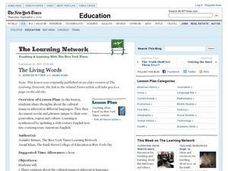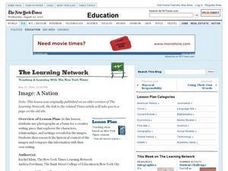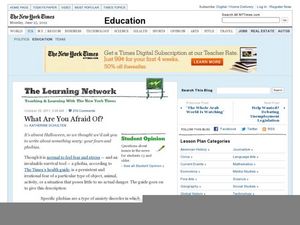Curated OER
Student Opinion: How Impulsive Are You?
Sure to spark lively discussion in any Language Arts classroom, this article from The York Times asks the question, 'How much self-control do you have?'. Pupils begin by reading a short passage about a study on delayed gratification and...
Curated OER
Picture This! Building Photo-Based Writing Skills
High schoolers analyze photographs as a development activity for their literacy skills. They will review the 6 Q's feature for analyzing photographs and analyze a variety of photographs and then write comments in the space around the...
Curated OER
The Living Words
Pupils translate a 16th century English text into contemporary English. They discuss the cultural uniqueness and significance of language and document words or phrases currently used in their daily lives. They use this list to aid in...
Curated OER
Fill-In: Dog TV
Should your dog be watching tV? Read the article and then fill in the blanks by memory. Encourage a friendly debate: would you get DogTV for your beloved pet?
Curated OER
A Hard Cell
Learners examine appropriate and inappropriate uses of personal communication devices. They invent and critique new communication devices. They critique the communication technologies developed.
Curated OER
Electric Exhibitions
Students, in this lesson plan, explore how modern technology can be used to enhance existing museum exhibits.
Curated OER
Mixing Metaphors with Politics
Students discuss different literary devices and use them to write summaries of New York Times articles dealing with international news. They reflect on the effectiveness and appropriateness of sports metaphors in the political arena.
Curated OER
Tinker Toys
Learners explore various computer items. They describe possible alternative uses for computer technology. Students explore the practice of "reverse engineering." They write an opinion essay on the ethics behind "reverse engineering."
Curated OER
Framing It
Students transform their everyday lives into artistic experiences. Based on "The Angel Project," students create an artistic project using their own school as both an inspiration and a backdrop.
Curated OER
Left to Their Own (Literary) Devices
Students write scenes for stories using their own original characters. However, they write using the literary and plot devices found in the Lemony Snicket book series.
Curated OER
Talking Over the Wall
Students explore how conflict resolution techniques can be used to resolve difference of opinion, both on a global and local scale. Students write in a journal about conflict using a phrase from the article as a starting point. ...
Curated OER
Setting the Stage from the Page
Students examine the differences between the portrayal of characters in books and in motion pictures. Using the novel, The Kite Runner, students discuss the ways in which the characters can be interpreted. Students create original...
Curated OER
Re-Viewpoints From 2002
Students explore how editorials use various devices to convey a message to a reader. They select key news topics from 2002 and write their own editorials.
Curated OER
Candid Cameras
Students read a New York Times article associated with the use of photography as a tool to depict social issues in order to provoke action. They create a Social Issues display.
Curated OER
Image: A Nation
Students use photographs as a basis for a creative writing piece that explores the characters, relationships, and settings revealed in the images.
Curated OER
Watch Out
Young scholars assess a time-related scenario at a railroad station. They study about the importance of a synchronized time system at Grand Central Terminal.They research various time measurement devices and develop "How It Works"...
Curated OER
The Truth Shall Set Them Free?
Students consider the notion and purpose of truth commissions, They work in groups to predict the commission's effectiveness in its efforts to promote peace and reconciliation among Liberians. Finally, students create found poems that...
Curated OER
Media Literacy Analyzed
Fourth and fifth graders define the term media literacy, then come up with examples that they share with the class. The types of media studied are auditory, visual, and written. Learners get together in pairs and perform a media...
Curated OER
Student Opinion: What Are You Afraid Of?
A great resource for informational texts as well as writing topics, the New York Times website provides writing prompts about various news articles through The Learning Network. This particular activity provides a very short reading...
Curated OER
Our Computers, Ourselves: Imagining the Digital Lives of Authors and Characters
The guiding question for this lesson is "Do computers and their contents shape who we are?" Open with a selection of Apple's commercials to introduce stereotypes and people's relationships with their computers. Then, read the attached...
Curated OER
School, Unplugged
What would school be like if you couldn't teach lessons that require technology? Would it benefit the class? Would it hold them back? Have your learners read this article and answer the basic reading comprehension questions. Then have...
Curated OER
Get the Message?
Remember Morse Code? High schoolers investigate ways in which people communicate and assess which communication methods are appropriate and effective in different situations. They evaluate how constant changes in the world of technology...
Curated OER
Speech! Speech!
Critical thinkers consider how word choice in speeches impacts the meaning and effectiveness of the message being presented. They examine and respond to some of the speeches made at the 2004 Republican and Democratic National Conventions.
Curated OER
Quiet on the Set!
In pairs learners perform a silent skit portraying relationships between two known characters from a popular book or a play for their classmates. Next, the class will read and discuss a NYTimes article about a film school in the Bronx...

























